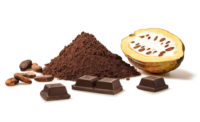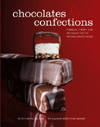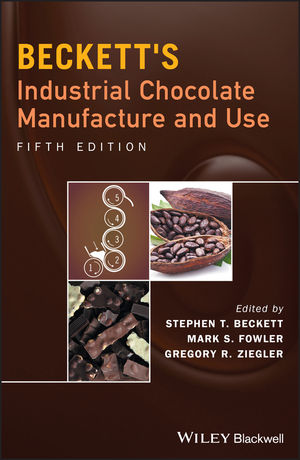
Pierson Clair, president and ceo of Brown & Haley, in front of a stain glass work by Cappy Thompson, Gathering the Light, 2003, a collection from the Museum of Glass in Tacoma.

Brown & Haley's management team by the canister packing line: (From l. to r.) Valencia Wolf, product manager; Mark Greenhall, chief marketing and sales officer; David Armstrong, senior v.p. - supply chain/operations; John Melin, coo; Pierson Clair, president and ceo; and Clarence Guimond, executive v.p., treasurer and cfo.
Not many midsized confectionery manufacturers talk about consumers having a “relationship” with their product. Pierson Clair, president and ceo of Brown & Haley, does.
Of course, Almond Roca isn’t your typical confection. Invented by founders J.C. Haley and Harry Brown in 1923, this log-shaped piece of buttercrunch toffee coated in rich chocolate and topped with almonds became the standard bearer for the Tacoma, Wash.-based Brown & Haley company.
Wrapped in gold foil and packaged in tins, Almond Roca evolved into the ideal gift-giving confection; this is what people gave – and give -- as gifts on special occasions to their family and close friends.
“The Almond Roca tradition has been passed on from grandmother to mother, from mother to daughter,” explains Clair. “It is an indulgent, very celebratory product.”
Even the manner in which Almond Roca’s gold foil is handled has importance for its consumers.
“There’s a ceremony attached to consuming Almond Roca butter-crunch,” adds John Melin, coo at Brown & Haley. “There’s a ritual in unwrapping the foil, flattening the foil and then folding it over slowly.”
Clair concurs, adding that it’s all about how consumers identify with Almond Roca, even to the point of handling the foil. “I’ve seen consumers fold it [the foil], twist it, even build a bird out of it.”
Given that Roca branded products comprise 80% of the company’s sales, estimated at $60 million annually, and that Almond Roca buttercrunch constitutes 60% of those branded revenues, it’s not surprising that Clair and his executive team value this special brand.
Thus, when Clair joined the company as part of an investor group buy-in in 1998, he understood that maximizing the brand’s potential without endangering its special relationship with consumers would take a special group of individuals.
At the same time, the former Blommer Co. executive (a 26-year veteran) recognized the importance of capitalizing on trends within the industry.
As Melin, whom Clair hired just months after being appointed ceo in 2003 to Brown & Haley, points out, the company focused much of its energies on non-Almond Roca products, everything from nut clusters to chocolate-enrobed confections.
“But all the profitability came from Almond Roca,” he says. Working in tandem with operations and sales, Melin systematically culled the non-performers from the company’s offerings, trimming 60% of the SKUs within a year.
Simultaneously, the push was on to update Almond Roca’s graphics as well as its packaging, what Melin calls “form factors,” essentially what size and shape make sense for the consumer and the marketplace.
Then there was Clair’s challenge of extending the Almond Roca brand through flavor variations.
“Historically, people always thought of ‘almond’ Roca,” Melin adds. “But as Pierson loves to point out, there are 16 edible nuts.”
And even more compatible flavor combinations. As coincidence would have it, the company had already embarked on a new Roca variety with Clair’s arrival, spurred on by its coffeehouse chain neighbor to the north, Seattle-based Starbucks. The U.S coffeehouse giant had recognized the value of adding pastries and other items as a means of upping the average cash register ring and had started working with Brown & Haley on developing a Mocha Roca offshoot, essentially an espresso coffee and buttercrunch toffee center enrobed in chocolate and topped with cashews.
New additions to the Clair management team, Mark Greenhall, chief sales and marketing officer, and Valencia Wolf, product manager, were in the process of joining Brown & Haley just about the time the Mocha Roca product was set to debut. Starbucks would distribute the new Mocha Roca item within its extensive network exclusively for 18 months.
Greenhall, who had previously worked for Ghiradelli as head of sales, and Wolf, who had left Starbucks as its product manager of packaged goods and had actually worked on Mocha Roca, were thrust into the company’s first serious brand extensions during the summer of 2004.
“Mocha Roca was in the midst of the Starbucks test and Cashew Roca was just starting to roll,” Greenhall explains. The subsequent acceptance by Starbucks and Brown and Haley customers opened the door for additional experimentation.
As Clair emphasizes, “We understood our relationship to the customer with the brand. By testing these flavors, we thought we could grow the brand. As it happened, the consumer gave us permission to do a lot of things with the brand. Once we established our team, it was a question of what does the brand allow?”
Consumers proved quite liberal on that account.

An APV Baker (now Baker Perkins) one-shot moulding line deposits an aggregate containing French caramel, almonds and buttercrunch toffee bits simultaneously with dark chocolate to produce the newly launched Roca Truffle Thins.
The next launch, which addressed two new issues – seasonality and a non-nut formulation – stirred some anxiety among the development team. Would Roca fans purchase Candy Cane Roca, a product that still featured the brand’s famed hard buttercrunch toffee center, but used bits of candy cane instead of nuts. Moreover, the chocolate layer was topped with streaks of white chocolate. Did this cross the boundaries of Roca?
Surprisingly, Candy Cane Roca, which Wolf says almost doubles as a breath mint in regards to flavor impact, was quickly accepted. Greenhall and Wolf saw the green light and accelerated product development.
The timing couldn’t have been better, particularly since the premium chocolate segment was beginning to take off. And even though Almond Roca was known as a premium confection that contained chocolate, it was not perceived as a premium chocolate, Greenhall points out.
“It was critical for us as a company to enter the premium chocolate arena, an arena that was experiencing 36% growth.”
It was also important for Brown & Haley to develop a product that fit into the everyday, self-consumption segment. As a “celebratory product,” Roca brand sales typically peaked during the major seasonal holidays – Valentine’s Day, Easter, Thanksgiving and Christmas. In addition, the demographic skewed toward an older consumer, 10 years older than the typical premium chocolate buyer.
“We wanted a product that was more accessible to a younger consumer,” Melin says.
“Not only did it have to appeal to a broader audience, but it had to have a new entry point – it was to be a gift for myself.”
The transition from celebratory to self-indulgence needed, however, to be based in Roca.
As Clair rightly points out, “The retailers were expanding their premium confections category. At the same time, they didn’t want to see another chocolate bar. In essence, all that would amount to was a different colored wrapper. They wanted a fresh, new premium product.”
And Clair’s team took on the challenge, one that encompassed two years of development before they settled on Roca Thins.
First, the product had to retain its Roca heritage, which begins with a buttercrunch toffee.
“We were looking for a toffee center, but as thin as possible,” Wolf explained. Initial concepts envisioned a 1-mm thick sliver of toffee covered in chocolate, but reality proved otherwise.
“We were able to get it down to between 6.5-7 mm,” says David Armstrong, senior v.p. – supply chain/operations. Using the same recipe, but alternating the cooking process, the company’s operations team delivered on the core concept, a thinner, workable buttercrunch toffee piece.
As Armstrong points out, “There’s a reason why you don’t see 1-mm slivers of toffee confections; most likely it can’t be done.”
Once the centers were established, Greenhall and Wolf focused on the chocolate nature of the products.
“We wanted both milk and dark toffee pieces,” adds Greenhall.
In searching for a milk chocolate, it was important that the milk chocolate be “smooth, velvety, have good texture and complement the toffee,” interjects Wolf.
Their search led them to a milk chocolate that had West African origins. It was also hot conched in order to bring out the brown sugar and caramelized notes.
Getting the right dark took a bit longer, however.
“Typically, dark chocolate doesn’t mesh with toffee well,” she says. “There’s an immediate conflict there, the bitterness fighting the sweet. As a result, the dark chocolate we wanted had to be mellow.”
After months of researching and testing, the team found its dark, a blend of Ecuadorian, Ivory Coast and Sulawesi beans. In addition, the chocolate had a 60% cocoa content.
“Sixty percent seems to be the magic number when it comes to antioxidants,” says Wolf. “It also seems to be the borderline for dark chocolate. We tested 70%, but it proved too bitter.”
To reinforce the premium chocolate connection, the buttercrunch toffee center would be double-enrobed, thus delivering a 60/40 chocolate to toffee ratio. Moreover, because of the toffee’s thinness, consumers would experience a slightly softer bite.
“That’s what many of our Almond Roca consumers had told us, that they love the product, but could we make the confection a little softer,” Greenhall says.
To that end, and because as Wolf points out, “Two SKUs don’t tell a story, you need to have a minimum of three, four items,” the team opted to introduce two new items, moulded chocolate products.
Using the same milk and dark chocolates developed for the new Roca Toffee Thins, Greenhall and Wolf once again focused on the buttercrunch toffee heritage to come up with an innovative center. For the milk chocolate, the center featured bits of California almonds and buttercrunch toffee with a soft creamy “French” caramel. The caramel is, of course, made in-house.
“For the dark chocolate, we wanted a rich truffle center, with a fudge-type consistency and plenty of almonds and buttercrunch toffee bits,” says Wolf.
Luckily, the company had an underutilized moulding line in its facility. Originally designed to produce 16 different flavored truffles simultaneously with four one-shot depositors, the line had already been modified to produce a variety of moulded products.
Moreover, the company had experience in producing centers with aggregate (hard inclusions such as nuts or hard candy bits), having done so seven years ago.
“We had to re-manufacture the depositing heads and depositing chambers to accept the almond and buttercrunch toffee pieces,” explains Armstrong. After several months of tweaking and testing, the moulded line started cranking out eight 40-piece moulds a minute.
“With time, we should be able to get it to 14 moulds a minute,” he asserts.
The successful product development of the Roca Toffee and Truffle Thins line coincided with the team’s efforts in coming out with the right package. As mentioned by Clair earlier, the idea of producing a bar item with just a different colored package wouldn’t necessarily stir any excitement amongst retailers.
Moreover, the very notion of self- reward suggested bite-sized products, thus granting permission to indulge with one, two or however many pieces.
“Originally, we debated the idea of long sticks,” Armstrong recalls. “Of course, that brought up a breakage issue during the cutting sequence.”
The stick size – 66 mm long – which required introducing special feeds on the Almond Roca toffee line, delivered the ideal essence of permissible self-indulgence. For the moulded line, it was just a case of coming up with a design and ordering moulds.
That left the packaging, which proved to be as challenging and innovative as the product itself.
“We were adamant about making the package size similar in depth, height and width as a premium bar,” says Greenhall. “This would allow placement within the premium chocolate bar display. This actually dictated our product development from the very beginning.”
Given the stick format, the package required a tray and a pad to cover the products.
In holding true to the self-indulgence concept, the package had to be “a gift box for yourself,” says Wolf. Convenience also played a role: easy open, easy close, easy carry.
That’s when the team came up with a recloseable flap. Atypical for a chocolate product, the flap enables a consumer to easily gain access to the tray containing the eight Toffee or Truffle Thins. Greenhall and Wolf credit their packaging suppliers with helping the company come up with the distinctive yet convenient gift box.
Scheduled to make its debut in April on the West Coast, the new Roca Toffee and Truffle Thins have already made quite an impression on buyers throughout the country.
But as Melin emphasizes, it’s important for a company the size of Brown & Haley to meet three “proof points.”
“First, we have to prove that we can manufacture it; second, we have to be able to have retailer sell-in; and third, we need to have consumer receptivity and off-take,” he says.
The company has met the first two and expects the third to follow once consumers actually taste the items.
Clair can barely contain himself when talking about the Thins.
“This isn’t a variation on a theme,” he says. “It’s a unique breakthrough. For toffee lovers we have classic Roca. And now, for chocolate lovers, we have Thins.”
Such enthusiasm extends throughout the executive team. Cautiously optimistic about the reception to Roca Thins, Greenhall and Wolf have developed gift box variations of the Roca Truffle concept in a praline format.
Featuring the same chocolate and virtually the same centers – “It’s the same formula, same profile, but in a different shape – the company will offer retailers Roca Double Dark Truffle and Milk Chocolate Crunch holiday boxes this coming season. The two new 3.7-oz items complement their classic counterparts, Almond Roca and Candy Cane Roca as affordable, gift-giving treats, ranging in price from $2.99-$3.49.
Here, too, the team came up with a packaging slight of hand: the gift boxes can be positioned horizontally or vertically based on need thanks to the appropriate face having been printed on one and the other side.
“It gives the retailer versatility,” points out Wolf.

For consumers seeking to make an even grander impression during the holidays, new rectangular tins holding Almond Roca and Roca Dark Chocolate Buttercrunch Truffles will address that need.
And speaking of needs, it’s important to note that Clair’s push to expand the Roca brand has also coincided with an ongoing effort to improve manufacturing efficiencies at the historical, four-story, 110,000-sq.-ft. plant sitting in the shadow of the Tacoma Dome.
Since his arrival, capital expenditures dedicated toward automation and efficiency enhancements have totaled several million dollars. Output has improved 27% as a result.
Take, for example, the installation of three new Foremost Fuji wrappers designed to handle count goods, such as the Almond Roca three- and one-piece packs.
“We not only have a better appearance, but they’re also hermetically sealed, which has increased our shelf life by 20%.”
Armstrong cites the acquisition of a Fresco packaging unit designed for handling standup pouches as well as a Storveyor used to regulate overflow and improve efficiencies in the foil wrapping as additional examples of addressing market and production needs.
He also credits the company’s engineering department for meeting the challenge to adapt or modify existing equipment, even breaking new ground as was necessary for Roca Thins recloseable flap.
“We worked with engineers from ADCO to make several substantial modifications in order to set up and form the package so it could accept the tray with product,” he says.
And although employees currently fill the eight-piece tray with Thins by hand, Armstrong foresees robotics fulfilling that role in the future.
Volume will dictate how quickly that happens, he says, but Armstrong has already performed a cost analysis regarding feasibility and payback.
Having enjoyed 8% compounded annual growth during the last four years, Brown & Haley had demonstrated that age and size aren’t necessarily deterrents to growth. Nor is that growth limited to one’s back yard; exports account for 20% of the company’s revenues (See sidebar). Rather, it’s all about a bit of vision and vibrancy.
As an employee of Brown & Haley for the past 42 years, Clarence Guimond, executive v.p., treasurer and cfo of the company, has a special perspective on the company’s past. He also has insight into the present and future.
“We’ve always had the people here to expand the brand,” he says. “But it was Pierson who demonstrated an ability to think out of the box. He’s very creative with unbounded imagination. He’s what this brand needed.”
At a glance
Headquarters: Tacoma, Wash.
Plant: One (110,000 sq. ft., three lines)
Plant: One (110,000 sq. ft., three lines)
Sales: $60 million (Candy Industry estimate)
Employees: 250
Output: 2 million Roca buttercrunch toffee pieces daily
Brands: Almond Roca, Cashew Roca, Mocha Roca, Roca Thins, Mountain Bars
Products: Buttercrunch toffee-based confections; chocolate sticks, pralines, bars.
Management team: Pierson Clair, president & ceo; John Melin, coo; Clarence Guimond, executive v.p., treasurer & cfo; David Armstrong, sr. v.p. – supply chain /operations; Mark Greenhall, chief marketing & sales officer; Valencia Wolf, product manager.










